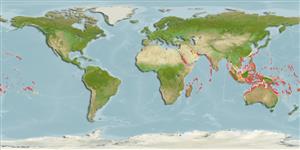Environment: milieu / climate zone / depth range / distribution range
Ecology
Marine; reef-associated; depth range 5 - 30 m (Ref. 9823). Tropical; 30°N - 28°S
Indo-Pacific: Red Sea to the Tuamoto Islands, north to Ryukyu Islands, south to Rapa.
Size / Weight / Age
Maturity: Lm ? range ? - ? cm
Max length : 18.0 cm TL male/unsexed; (Ref. 30573)
Dorsal
spines
(total): 9;
Dorsal
soft rays
(total): 12;
Anal
spines: 3;
Anal
soft rays: 11 - 13. Body brown, shading to yellow on abdomen, thorax and lower head, and to reddish posteriorly; reddish lips; posterior of operculum with a large black spot, a green spot above and adjacent to this, and above this is a red spot. Pectoral base with a dark brown bar. Dorsal spines pungent.
Adults occur in clear lagoon and seaward reefs from the lower surge zone to a depth of 30 m (Ref. 1602). Usually in areas with mixed rubble, coral, or rock and sand (Ref. 9710). Usually solitary among large corals. Small juveniles swim with their head down, keeping dorsal and anal fins erected, and may seem like the face of a larger fish when viewed from side on by a predator (Ref. 48636). Oviparous, distinct pairing during breeding (Ref. 205). Occasionally seen in fish markets and aquarium trade.
Life cycle and mating behavior
Maturity | Reproduction | Spawning | Eggs | Fecundity | Larvae
Oviparous, distinct pairing during breeding (Ref. 205).
Westneat, M.W., 2001. Labridae. Wrasses, hogfishes, razorfishes, corises, tuskfishes. p. 3381-3467. In K.E. Carpenter and V. Niem (eds.) FAO species identification guide for fishery purposes. The living marine resources of the Western Central Pacific. Vol. 6. Bony fishes part 4 (Labridae to Latimeriidae), estuarine crocodiles. FAO, Rome. (Ref. 9823)
IUCN Red List Status (Ref. 130435)
Threat to humans
Harmless
Human uses
Fisheries: minor commercial; aquarium: commercial
More information
ReferencesAquacultureAquaculture profileStrainsGeneticsElectrophoresesHeritabilityDiseasesProcessingNutrientsMass conversion
Tools
Special reports
Download XML
Internet sources
Estimates based on models
Preferred temperature (Ref.
123201): 24.9 - 29.3, mean 28.2 °C (based on 2766 cells).
Phylogenetic diversity index (Ref.
82804): PD
50 = 0.5002 [Uniqueness, from 0.5 = low to 2.0 = high].
Bayesian length-weight: a=0.00977 (0.00470 - 0.02030), b=3.07 (2.89 - 3.25), in cm total length, based on LWR estimates for this (Sub)family-body shape (Ref.
93245).
Trophic level (Ref.
69278): 3.5 ±0.37 se; based on food items.
Resilience (Ref.
120179): High, minimum population doubling time less than 15 months (Preliminary K or Fecundity.).
Fishing Vulnerability (Ref.
59153): Low vulnerability (10 of 100).
Nutrients (Ref.
124155): Calcium = 76.6 [46.0, 126.8] mg/100g; Iron = 0.683 [0.402, 1.246] mg/100g; Protein = 18.5 [15.6, 20.7] %; Omega3 = 0.153 [0.101, 0.236] g/100g; Selenium = 23.8 [14.6, 42.4] μg/100g; VitaminA = 138 [43, 498] μg/100g; Zinc = 1.61 [1.12, 2.51] mg/100g (wet weight);
